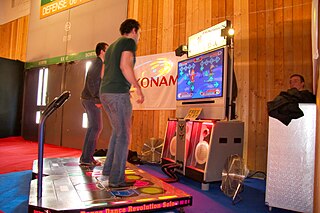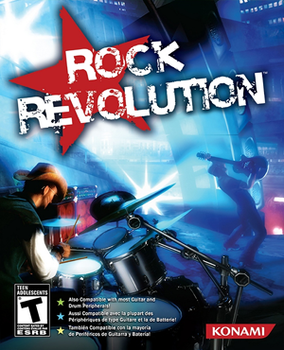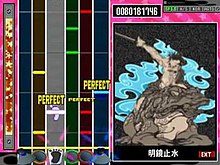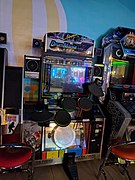Dance Dance Revolution (DDR) is a music video game series produced by Konami. Introduced in Japan in 1998 as part of the Bemani series, and released in North America and Europe in 1999, Dance Dance Revolution is the pioneering series of the rhythm and dance genre in video games. Players stand on a "dance platform" or stage and hit colored arrows laid out in a cross with their feet to musical and visual cues. Players are judged by how well they time their dance to the patterns presented to them and are allowed to choose more music to play to if they receive a passing score.
Beatmania (ビートマニア) is a rhythm video game developed and distributed by Japanese game developer Konami and first released in December 1997. It contributed largely to the boom of music games in 1998, and the series expanded not only with arcade sequels, but also moved to home consoles and other portable devices, achieving a million unit sales. The Bemani line of music games from Konami is named after the series, was first adopted in the arcade release of Beatmania 3rdMix and kept ever since. The series came to an end with the last game being Beatmania The Final, released in 2002.
Dancing Stage is a series of music video games developed and published by Konami. It is a spin-off of Dance Dance Revolution for the European market as well as a few Japanese titles. Games were released for arcade, PlayStation, PlayStation 2 and Wii.

Beatmania IIDX (IIDX) is a series of rhythm video games, that was first released by Konami in Japan on 26 February 1999. Beatmania IIDX has since spawned 31 arcade releases and 14 console releases on the Sony PlayStation 2. It is the sequel to the beatmania game series, and is part of the Bemani line of music games.
Bemani, stylized as BEMANI, is Konami's music video game division. Originally named the Games & Music Division (G.M.D.), it changed its name in honor of its first and most successful game, Beatmania, and expanded into other music-based games, most notably rhythm games such as Dance Dance Revolution, GuitarFreaks, and DrumMania.

Keyboardmania is a rhythm video game created by the Bemani division of Konami. In this game up to two players use 24-key keyboards to play the piano or keyboard part of a selected song. Notes are represented on-screen by small bars that scroll downward above an image of the keyboard itself. The goal is to play the matching key when a note bar descends to the red play point line. The arcade cabinet has two screens - one for each player.

ParaParaParadise is an arcade and PlayStation 2 dance game made by the Japanese company Konami and released under the Bemani moniker following the Para Para fad.

Rhythm game or rhythm action is a genre of music-themed action video game that challenges a player's sense of rhythm. Games in the genre typically focus on dance or the simulated performance of musical instruments, and require players to press buttons in a sequence dictated on the screen. Many rhythm games include multiplayer modes in which players compete for the highest score or cooperate as a simulated musical ensemble. Rhythm games often feature novel game controllers shaped like musical instruments such as guitars and drums to match notes while playing songs. Certain dance-based games require the player to physically dance on a mat, with pressure-sensitive pads acting as the input device.

Yoshitaka Nishimura (西村宜隆), better known as DJ Yoshitaka, is a composer for Konami's line of Bemani games. He has been making solo songs since the release of Beatmania IIDX 11: IIDX Red, though he has had previous Bemani involvement as a member of Osamu Migitera's Des-ROW group. He often composes for the Beatmania IIDX and the Pop'n music series, and then began composing for the Guitar Freaks & DrumMania and the Dance Dance Revolution series in 2005 and 2007, respectively. DJ Yoshitaka still often works with Des-ROW for some Pop'n music songs. In the Reflec Beat series, DJ Yoshitaka regularly appears alongside fellow composer Sota Fujimori as a double act, Venus.

Dance Dance Revolution Extreme is a music video game by Konami and is the eighth release in the main Dance Dance Revolution (DDR) series. It was released on December 25, 2002, for Japanese arcades, on October 9, 2003, for the Japanese PlayStation 2, and on September 21, 2004, for the North American PlayStation 2. This game is the ninth release in North America, but despite having the same name as its Japanese counterpart, its gameplay and soundtrack is significantly different and won the Video Music Awards in 2005 on MTV for Best Video Game Soundtrack.

beatmania IIDX 3rd Style is a music video game developed by Bemani and published by Konami, initially released as an arcade game in Japan on February 25, 2000, and subsequently ported to the PlayStation 2 on November 2. 3rd Style removed the 4-keys mode from previous installments and replaced it with the Light7 difficulty, giving most songs a fully separate, easier notechart. The game also introduced Free Mode and Extra Stage, and featured a new aesthetic.

Dance Dance Revolution Solo is a series of games spun off of the main Dance Dance Revolution series. It consists of three arcade releases in Japan. The game mode was also adapted for use in a children's arcade version and two console releases.

Beatmania IIDX is an arcade music video game developed by Bemani and published by Konami. It was released in Japan on February 26, 1999. The objective is to perform songs using a controller with seven keys and a turntable. After the surprise success of Beatmania, Benami conceived IIDX to simulate an actual disc jockey (DJ) live performance. Its arcade cabinet contains a widescreen monitor, speakers, and eight spotlights. Bemani later developed several updated versions of IIDX to increased success. The game retrospectively received a positive reception from video game publications for its gameplay and increased difficulty. A sequel, Beatmania III, was released in 2000.

Rock Revolution is a music video game developed by Zoë Mode and HB Studios and published by Konami. The game was released on 15 October 2008 for the Nintendo DS, PlayStation 3, Wii and Xbox 360. As with similar titles, the game uses various controllers to simulate the performance of rock music, primarily using guitar and drum controllers on its Xbox 360 and PlayStation 3 versions.

Ninezero is an Australian rock/metal singer, songwriter and musician. He is influenced by heavy metal and hard rock to create a new kind of sound, referred to as power cacophony metal. Born in Sydney, Australia. He currently resides in Tokyo, Japan.
Dance Dance Revolution Extreme has a robust soundtrack. It includes many licensed tracks as well as in-house original music that was written and performed by Konami staff.

The System 573 is an arcade system board made by Konami based on the original PlayStation. The hardware was used primarily for Konami's Bemani series of music video game arcades, including the popular Dance Dance Revolution series introduced in 1998. The System 573 is available is configurable with various expansion IO boards to add extra input or output, such as the analog and digital I/O boards for Dance Dance Revolution and other Bemani games. Systems with these IO boards are often called System 573 Analog and System 573 Digital respectively. There is another variant called the System 573 Satellite Terminal which allows for up to eight cabinets to be networked to a central one.

Dance Dance Revolution A20 is a music video game, the 17th installment of the Dance Dance Revolution arcade series in Japan, and the sequel to Dance Dance Revolution A. The game was released on new, golden cabinets on March 20, 2019, in Japan. A software upgrade for older cabinets for Japan and Asia was released on July 24, 2019, with South Korea receiving a localized release on August 1, 2019, and North America on September 24, 2019. A location test in Europe began on October 7, 2019, and ended on March 16, 2020.

























